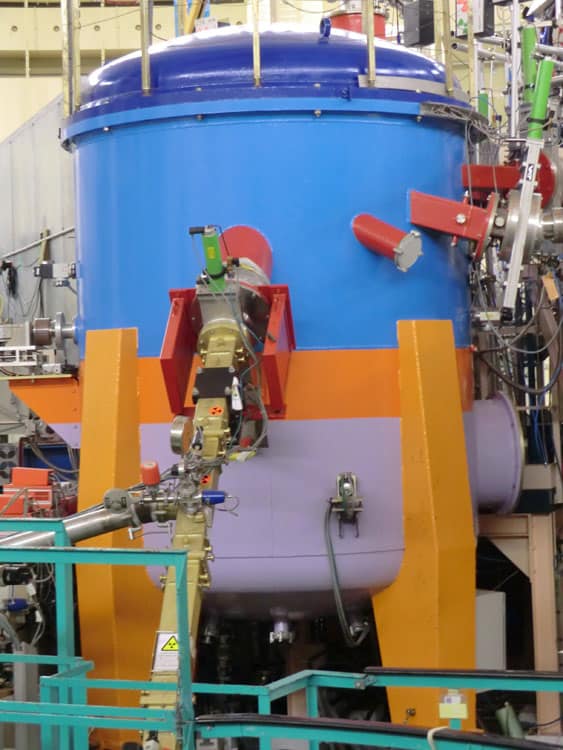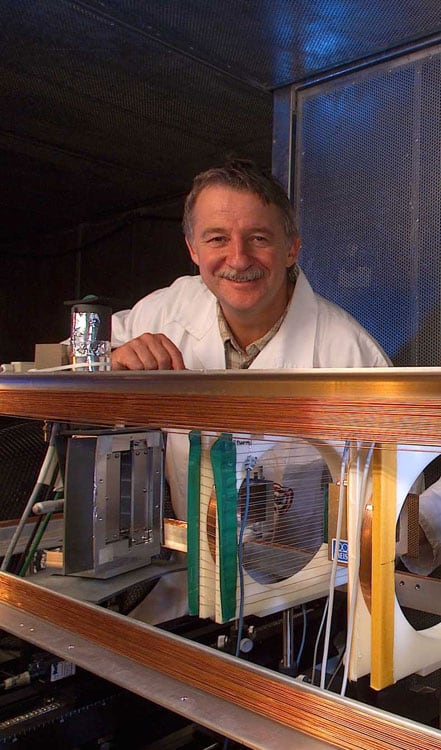The Institut Laue-Langevin (ILL) in Grenoble, France, is best known as a world-class neutron-scattering facility that has made breakthroughs in condensed-matter physics, materials science, chemistry and biology. But it also produces ultracold neutrons that are used to study esoteric problems in cosmology and particle physics. Hamish Johnston talks to ILL physicists Peter Geltenbort and Oliver Zimmer about what these neutrons could tell us about dark matter, gravity and conditions just after the Big Bang

So what are ultracold neutrons?
Peter Geltenbort: The “thermal neutrons” produced by a research reactor such as ILL have energies of a few hundredths of an electron volt. On average they travel at about 2200 m/s. The ultracold neutrons (UCNs) that we work with have speeds of about 5–8 m/s – so even I can run faster than a UCN.
How are they produced at ILL?
PG: The first step is to make thermal neutrons from the much more energetic “fission neutrons” that are produced in the ILL’s reactor. This happens naturally when these neutrons collide with deuterium nuclei in the heavy water within the reactor core. Some of these thermal neutrons are then cooled further through collisions in vessels close to the core that are filled with liquid deuterium at about 25 K, which takes the speed down to about 700 m/s. Next, some of these neutrons are guided up using a special pipe, which transmits only neutrons with lower energies – so at the top they emerge with speeds of about 50 m/s.
The neutrons are then piped into a large vacuum vessel above the reactor core, containing a turbine with rotating metal blades. The neutrons hit the blades, which rotate backwards and cause the neutrons to lose kinetic energy. It’s the same as when you’re playing tennis and instead of striking the ball you pull back your racquet. In physics terms this is a Doppler shift of the neutron from a velocity of about 50 m/s down to about 5 m/s.
What can physicists learn from studying extremely cold neutrons?
Oliver Zimmer: The nice thing about the neutron is that it is a complete laboratory – it feels all types of forces including gravity and magnetic forces, the weak force responsible for radioactivity and the strong force that keeps the particles bound together in atomic nuclei. It even responds to electric fields – although this might sound strange because the neutron has no electrical charge. However, the neutron has a rich internal structure and contains quarks, which are charged particles. The quarks are subject to the strong and weak forces. The weak force also gives rise to the decay of the neutron, which can be best studied by trapping UCNs in bottles and watching them decay.
So you do particle physics using UCNs?
PG: Yes, but in a different way from a high-energy physics lab like CERN, which tries to reproduce the conditions less than a microsecond after the Big Bang. With UCNs we look for the consequences of the Big Bang at very high precision.
OZ: Interactions between particles are mediated by particles called bosons. In an accelerator the energy is often high enough to produce these bosons and see how they decay. In UCN research you don’t actually produce these bosons as free particles. Instead, you see their effects indirectly in the static and decay properties of the neutron. With the stunningly high precision of some experiments you can learn about the fine details of fundamental interactions and possibly even find hitherto unknown forces – that’s the beautiful thing about this research.
What have you learned so far?
PG: A recent example is that physicists at ILL have measured for the first time the quantum gravitational states of the neutron, which is done by bouncing UCNs on a very smooth mirror. The repulsive force from the mirror pushes the neutrons up, while gravity pushes them down. The effect is to confine the neutrons in a potential well and quantum mechanics tells us that the neutrons exist in distinct energy levels.
This was demonstrated by bringing a second, absorbing surface down to the mirror and then slowly pulling it upwards. We measure how many neutrons can fly through this gap and find that there are none until the upper surface reaches the height for which the first gravitational quantum state fits in the gap. As the height is raised further, a step-like intensity increase indicates transmission via the subsequent quantum states.
OZ: Physicists from Vienna and the ILL have now even started to do spectroscopy of these gravitational states. You can think of the neutron on a mirror being much like an atom that is being excited using light – shifting the atom from one electronic state to another. Similarly, jumps between different gravitational quantum states of the neutron are induced by vibrating the mirror and the energy quanta involved in these transitions are detected as resonances that occur at certain vibrational frequencies. The success of this experiment gives us hope that we will be able to use spectroscopy to check Newton’s gravity law at micron distances.
If we found a deviation, what would that tell us?
OZ: It is not understood why gravity is so weak compared with the other known fundamental interactions. On the other hand, there are now many theoretical models predicting the existence of “extra” dimensions – in addition to the space and time of our 4D universe. Quite generically, in such scenarios gravity would become much stronger at short enough distances where these extra dimensions would manifest themselves. A deviation from Newton’s law on the micron scale found with spectroscopy of neutrons close to a mirror surface would indeed be a spectacular support of such theoretical ideas.
What are neutron oscillations and how could UCNs shed light on them?
OZ: An example is the oscillation of a neutron into an antineutron. This is a process forbidden by the Standard Model of particle physics and is therefore a very interesting testing ground to search for new physics. A strong limit on the oscillation period of three years was set at the ILL more than 20 years ago in an experiment using cold neutrons. With the advent of new UCN sources there is some hope to either push this limit further or – even better – discover a neutron–antineutron oscillation using UCNs.
I’ve heard about something called the mirror neutron – what’s that?
It’s a hypothetic particle proposed by theorists as a viable candidate of dark matter – the “missing matter” that we know must exist in our universe. Like dark matter, we would feel only the gravitational effects of mirror neutrons. The basic idea is the existence of a “mirror world” immersed in our world in which particles would behave the same way, apart from the left-handedness of the weak interactions. In the mirror world, weak interactions would be right-handed. A neutron might oscillate into its mirror partner and such an effect can be very well examined using UCNs. Indeed, the first experiments have been carried out at ILL to look for it.
What are your next plans?
OZ: We are currently building a new apparatus to significantly improve the knowledge of the neutron lifetime, which is a very important ingredient for understanding how the light chemical elements formed after the Big Bang. We will use a magnetic trapping technique where the neutrons never touch the walls of the container so cannot get lost through such contact, which has been a major difficulty in past experiments.
There is also a very interesting theoretical prediction of a nonlinear effect due to fluctuations in the quantum-electrodynamic vacuum. As you know, the vacuum is far from being “empty” – virtual electron–positron pairs constantly appearing and vanishing make it resemble a medium that can be polarized. Theorists have predicted that a neutron moving in the strong electric field close to a heavy atomic nucleus would develop an induced electric dipole field. We hope to be able to demonstrate this astonishing nonlinear effect in a neutron-scattering experiment. If succesful, it would provide a first observation of a violation of the superposition principle for classical electric and magnetic fields. We hope to be able to report good news on this soon.
PG: For me, an interesting project is the search for an electric dipole moment of the neutron. The Standard Model of particle physics predicts that this dipole moment is extremely small. However, if it is bigger than expected, that could point towards new physics that could explain why there is much more matter than antimatter in the universe.
This idea was proposed by Norman Ramsey and Edward Purcell in 1950 and the first experiment putting an upper limit on the dipole moment was done at Oak Ridge National Laboratory a year later. In the last 60 years we have been trying to measure what is essentially zero with ever higher precision. There is a nice way to look at the problem: imagine the neutron as blown up to the size of the Earth. The current experimental sensitivity of the electric dipole moment would then correspond to a separation of two elementary electric charges in this Earth-sized object by only 3 µm.





